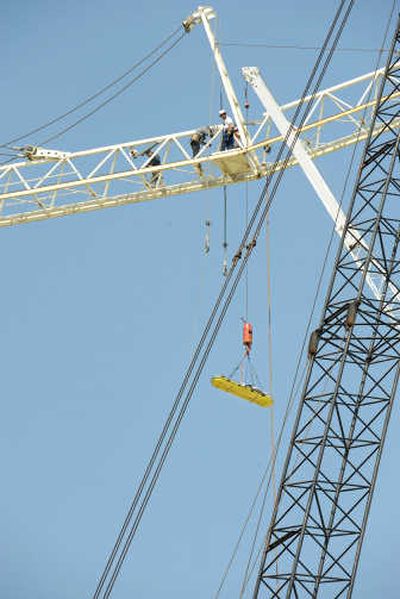Regulations are elusive for crane industry

NEW YORK — Dan Mooney has no idea what it will take for his construction cranes to pass inspection.
The crane company owner recently asked New York City officials for a list of safety hazards that inspectors look for. He was told that information wasn’t public.
“How am I supposed to know what I need if you won’t tell me?” Mooney asked. “It’s like not posting the speed limit.”
In 35 other states, crane companies face a different problem: Operators don’t need licenses of any kind.
An Associated Press analysis found that cities and states have wildly varying rules governing construction cranes, and some have no regulations at all, choosing instead to rely on federal guidelines dating back nearly 40 years that some experts say haven’t kept up with technological advances.
Crane safety is getting extra scrutiny following an alarming number of crane-related deaths in recent months in places such as New York, Miami and Las Vegas. In New York City, two crane accidents since March have killed nine people — a greater number than the total deaths from cranes over the past decade.
Many states have no count of their cranes, nor do they mandate training for workers who run the equipment, or for officials who certify crane operators. Even the federal government acknowledged last month that updated standards would prevent some crane accidents.
New York City has only four inspectors on the payroll to inspect more than 200 cranes, 26 of them large tower cranes. About four inspections are conducted each day, a routine that one 40-year industry veteran said won’t detect real problems such as the rebuilt crane part blamed for a crane collapse last month.
“That’s impossible,” said Ron Brodek, an inspector from Chandler, Ariz. “You’re just looking through the paperwork then. It’s a drive-by inspection.”
The crane standards of the Occupational Safety and Health Administration were last updated in 1971. They require cranes to be inspected once a year. But most of the inspections never happen. OSHA, which is part of the Labor Department, inspected only about 23,000 of the country’s some 4 million construction sites last year.
Labor Department spokeswoman Sharon Worthy said she didn’t know how many of those sites had cranes, but the federal government last year issued $500,000 in annual penalties for crane violations.
Updating the regulations, Worthy said, “is a top regulatory priority” for the agency. But approving the rules could still take more than a year after the Labor Department finishes an internal review of the proposed new regulations.
Running a crane is among the most highly specialized skills in construction. Operators of tower cranes, like the two that collapsed into Manhattan residential neighborhoods, cannot see the loads they’re picking up and must use a radio to communicate with workers on the ground.
One wrong move can bring tragic consequences. In March, two construction workers in Florida were killed when a crane plummeted 30 stories onto a condo project. More than 50 people have died in crane accidents in Florida over the past decade.
“There’s certification for your plumbers, your pipe fitters,” said John Lindsey, a crane operator and treasurer of his union local in Jefferson City, Mo. “Why in the heck won’t they hear about certification for your operators?”
Bruce Whitten, chairman of the Florida Crane Owners Council, bemoaned the state’s lack of licensing requirements for crane operators.
“Anyone can operate a crane,” he said. “I can take you over there and you can go operate a crane.”
But Whitten was among industry leaders who sued to block Miami-Dade County crane ordinances enacted last spring that would have required that operators be licensed and that cranes withstand wind speeds of 140 mph. The lawsuit said none of the 200 cranes operating in the county could meet the standard.
Florida lawmakers introduced a bill that reduced the wind speed limit to 120 mph and required a national operator’s test, but Miami-Dade legislators blocked it, saying it would weaken local standards.
After the March 15 crane collapse in Manhattan that killed seven people, Dallas checked its 23 cranes and found that eight had uncertified operators at the controls.
In states that only go by OSHA standards, annual crane inspections are largely a matter of self-policing by crane owners. Federal law requires that inspection records be kept, but not submitted. Some owners cut corners and avoid the inspections.
“There are people who don’t do it because they know their machinery will not pass code,” said John Alexander, an inspector for Cranetex Services in Austin, Texas. “There are people who will give the excuse that they can’t afford it.”